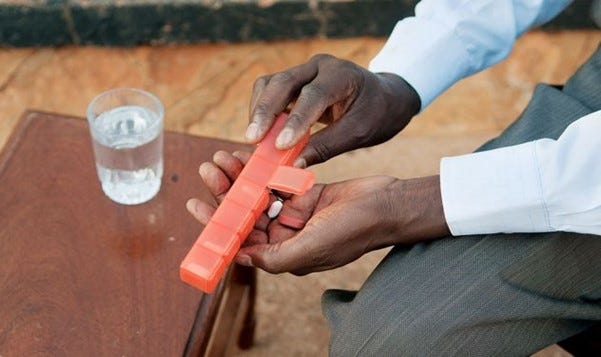Reflections on HIV in Botswana: Progress and Challenges in Rural Areas
By Thabo Sebobi, MA Student, Binghamton University and Student Representative of Rural Geography Specialty Group for the American Association of Geographers
For decades, HIV has been a significant health issue in Botswana. At the peak of the epidemic in the late 1980s – early 1990s, close to 40% of the country’s adult population was infected with the virus, one of the highest prevalence rates in the world. Since then, Botswana has been a leader in the fight against HIV, taking important steps to control the epidemic and improve the lives of those affected by the virus. This essay reflects on how far Botswana has come in tackling HIV, and it goes on to explore the challenges that remain, especially in rural areas.
In the early years of the HIV epidemic in Botswana, the situation was dire. Access to HIV treatment was very limited, and many people did not know much about the virus or how it spread. Stigma and discrimination against people living with HIV were also widespread, especially in rural areas where information and resources were scarce. For instance, some linked the virus to sexual immorality and promiscuity. Furthermore, other people believed that having sexual intercourse with a virgin could cure the virus, while others were of the view that drinking plenty of water after sexual intercourse could flash away the virus as well as other sexually transmitted diseases. Traditional healers, on the other hand, associated HIV with “Boswagadi,” which means one would have done something to offend their ancestors, and the virus was a punishment for that. At that time, there was also little hope for those who were infected as antiretroviral (ARV) drugs were not widely available in the country. Consequently, high rates of HIV-related illnesses and deaths were recorded.
Despite these challenges, Botswana worked tirelessly around the clock to tackle the epidemic. The MASA (New Dawn) treatment program was launched in 2002, and the objective of the program was to improve access to ARV treatment in Botswana (Ramogola-Masire et al., 2020). That same year, the government of Botswana collaborated with the Merck Foundation and the Bill and Melinda Gates Foundation to establish the African Comprehensive HIV/AIDS Partnership (ACHAP) (Ramogola-Masire et al., 2020). Through this partnership, over half of pregnant women in Botswana who were undergoing prenatal care were tested and made aware of their HIV status (Ramogola-Masire et al., 2020), and if positive, immediately enrolled in the Prevention of Mother-to-Child Transmission of HIV/AIDS (PMTCT) program. The U.S. government’s PEPFAR also began supporting Botswana, providing training and mentorship to healthcare workers, and expanding access to voluntary testing and ARV treatment (Ramogola- Masire et al., 2020). In its endeavors to increase access to PMTCT and ARV programs and to treat as many people infected with the virus as possible, the government in 2004 further initiated the routine, non-compulsory “opt-out” HIV screening services in prenatal and other health care services. Through this move, the government moved away from strategies aimed at behavior change, such as condom use, and emphasized universal access to ARV treatment. In June 2016, Botswana further introduced the “Treat All” strategy. Through this strategy, the government aimed to enroll all citizens and non-citizens into the ARV program immediately after testing positive for HIV, regardless of their CD4 count. Other strategies developed by the government include the infusion of HIV/AIDS topics in the school curriculum, and this was meant to strengthen the nation's capacity in terms of education and communication regarding the virus.
Picture Source: UNAIDS (https://www.unaids.org/sites/default/files/styles/webstory_ptohogallerytopimage/public/20190924_botswana.jpg?itok=7L6QeyK5)
As shown above, Botswana has, over the years, considerably done well in developing relevant public health strategies and programs to eliminate HIV, and these interventions have immensely contributed to the country’s achievement of the 95-95-95 UNAIDS goals. Results from the fifth Botswana Aids Impact Survey (BAIS V) indicate that Botswana has considerably surpassed the UNAIDS 95-95-95 targets, which direct that by 2025, at least 95% of people living with HIV are fully aware of their condition, 95% of those aware of their HIV status are enrolled on the ART treatment, and lastly 95% of those on ART have an undetectable viral load.
While Botswana has made great progress in the fight against HIV, rural areas continue to face unique challenges.
Many rural communities are geographically isolated, making access to healthcare facilities more difficult. People living in these areas often have to travel long distances to reach clinics where they can get tested or receive medication. This can be a major barrier, especially for those without reliable access to public transportation. Rural areas in Botswana also tend to have fewer healthcare workers, which puts a strain on the available services. The healthcare workers who are present often must manage large numbers of patients. Additionally, rural healthcare facilities are sometimes under-resourced and lack the necessary equipment to provide comprehensive HIV care.
Stigma and misinformation about HIV also tend to be more prevalent in rural areas. In these communities, people still associate HIV with shame and bad luck, and this discourages individuals from getting tested or disclosing their status to their loved ones. This makes it harder to control the spread of the virus, as people may continue to transmit HIV to others unknowingly.
Moving forward, addressing these challenges in rural areas is essential to further reducing the impact of HIV in Botswana. Improving access to healthcare in rural areas through, for instance, mobile clinics, strengthening rural healthcare infrastructure, and reducing stigma through education programs are also crucial steps.
— Thabo Sebobi
Authors Bio

Connect with us at:
Thanks for reading Just Rural Futures! Subscribe for free to receive new posts and support my work.






